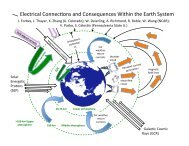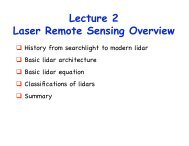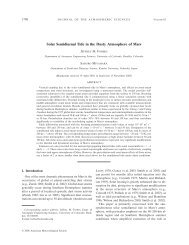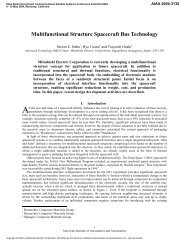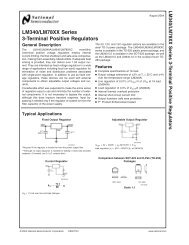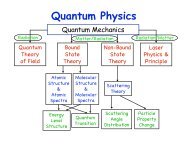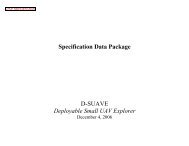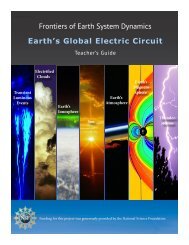Impact of electrified clouds to the GEC - University of Colorado at ...
Impact of electrified clouds to the GEC - University of Colorado at ...
Impact of electrified clouds to the GEC - University of Colorado at ...
Create successful ePaper yourself
Turn your PDF publications into a flip-book with our unique Google optimized e-Paper software.
A Short Review <strong>of</strong> Thunders<strong>to</strong>rm<br />
Electrific<strong>at</strong>ion<br />
<strong>Impact</strong> <strong>of</strong> <strong>electrified</strong> <strong>clouds</strong> <strong>to</strong><br />
<strong>the</strong> <strong>GEC</strong><br />
Wiebke Deierling
Thunders<strong>to</strong>rm Electrific<strong>at</strong>ion<br />
Strong field, labora<strong>to</strong>ry and modeling evidence suggests th<strong>at</strong><br />
precipit<strong>at</strong>ion-based charging is <strong>the</strong> primary candid<strong>at</strong>e for<br />
thunders<strong>to</strong>rm electrific<strong>at</strong>ion.<br />
Precipit<strong>at</strong>ion-based charging can be divided in<strong>to</strong>:<br />
‣ Inductive charging<br />
‣ Non inductive charging<br />
2
Thunders<strong>to</strong>rm Electrific<strong>at</strong>ion<br />
Inductive charging mechanisms:<br />
‣ Rebounding collisions between hydrometeors th<strong>at</strong> became<br />
polarized by an existing vertical electric field.<br />
‣ Role <strong>of</strong> inductive<br />
charging not entierly<br />
known but it is<br />
hypo<strong>the</strong>sized th<strong>at</strong> it can<br />
intensify electrific<strong>at</strong>ion<br />
once it is initially achieved<br />
by o<strong>the</strong>r mechanisms.<br />
From MacGorman and Rust, 1998<br />
3
Non inductive charging<br />
mechanism:<br />
‣ Independent <strong>of</strong> an ambient<br />
electric field<br />
‣ Charging occurs in strong<br />
updraft within mixed phase<br />
region<br />
Thunders<strong>to</strong>rm Electrific<strong>at</strong>ion<br />
‣ Rebounding collisions<br />
between riming ice particles<br />
(e.g. graupel pellets) and ice<br />
crystals in presence <strong>of</strong><br />
supercooled liquid w<strong>at</strong>er<br />
From Dye 2011;<br />
‣ Sign and magnitude <strong>of</strong> charge transfer depends on effective liquid<br />
w<strong>at</strong>er content, temper<strong>at</strong>ure, size <strong>of</strong> ice, impact velocity, growth regime<br />
(diffusion or sublim<strong>at</strong>ion), contaminants in ice<br />
4
Thunders<strong>to</strong>rm Electrific<strong>at</strong>ion<br />
‣ Inductive charging can generally explain <strong>the</strong> thunders<strong>to</strong>rm charge<br />
structure<br />
In situ<strong>at</strong>ions where<br />
LWC = 1 g/m 3 , <strong>the</strong>n:<br />
- graupel becomes<br />
neg<strong>at</strong>ively charged<br />
around -15C and<br />
ice crystals become<br />
positively charged<br />
- reverse occurs between<br />
0 <strong>to</strong> -5C<br />
Gravit<strong>at</strong>ional sorting <strong>of</strong> hydrometeors<br />
leads <strong>to</strong> charge separ<strong>at</strong>ion<br />
Saunders (1993)<br />
5
NASA’s Airborne Field Mill Project 2000-01<br />
Charging without liquid w<strong>at</strong>er in thunders<strong>to</strong>rm anvils<br />
Flight<br />
track <strong>at</strong><br />
10 km<br />
dBZ <strong>at</strong> FL<br />
Total lightning<br />
Reflectivity curtain along<br />
A/C track.<br />
Electric Field (kV/m)<br />
Total Field == bold line<br />
Vertical E == light line<br />
The abrupt increase <strong>of</strong> electric field <strong>at</strong> ~10 dBZ!<br />
N<strong>at</strong>ional Security Applic<strong>at</strong>ions Program<br />
Research Applic<strong>at</strong>ions Labora<strong>to</strong>ry<br />
ATEC-4DWX Forecasters’ Training<br />
Courtesy: 29-31 March 2011, Jim Boulder, Dye <strong>Colorado</strong> 6
Thunders<strong>to</strong>rm Electrific<strong>at</strong>ion<br />
From:http://www.nssl.noaa.gov/primer/lightni<br />
ng/ltg_basics.html<br />
From Encyclopedia Britannica<br />
7
Thunders<strong>to</strong>rm Electrific<strong>at</strong>ion<br />
from Krehbiel, 1986<br />
MCS<br />
Charge structures<br />
can be more<br />
complic<strong>at</strong>ed….<br />
Height <strong>of</strong> charge<br />
layers vary by s<strong>to</strong>rm<br />
type and during<br />
lifecycle <strong>of</strong> s<strong>to</strong>rm<br />
Inverted polarity<br />
s<strong>to</strong>rms, as observed<br />
<strong>at</strong> Tibetean Pl<strong>at</strong>eau<br />
and High Plains<br />
8
Thunders<strong>to</strong>rm Electrific<strong>at</strong>ion<br />
Cloud Type<br />
Inside thunders<strong>to</strong>rms<br />
Initi<strong>at</strong>ion <strong>of</strong> n<strong>at</strong>ural lightning<br />
Breakdown in clear air<br />
Shower <strong>clouds</strong> (no ltg)<br />
Anvil and debris <strong>clouds</strong><br />
Layered Clouds (e.g.<br />
Nimbostr<strong>at</strong>us, Stra<strong>to</strong>cumulus)<br />
Fair wea<strong>the</strong>r electric field close<br />
<strong>to</strong> surface, no <strong>clouds</strong><br />
Typical Electric Field Value<br />
~ 70-200 kV/m<br />
~ 200 kV/m<br />
~ 3000 kV/m<br />
~ 0.1-100 kV/m<br />
~ 10 - 100 kV/m<br />
~ 1-30 kV/m<br />
~ 0.1 kV/m<br />
9
The Role <strong>of</strong> Electrified Clouds in <strong>the</strong> Global<br />
Electric Circuit<br />
Wiebke Deierling, Tina Kalb<br />
10
Thunders<strong>to</strong>rms & Global Electric Circuit<br />
Beginning <strong>of</strong> 20 th Century<br />
- Global electric field measurements<br />
- Daily vari<strong>at</strong>ions <strong>of</strong> fair wea<strong>the</strong>r<br />
electric field with universal time<br />
- Thunders<strong>to</strong>rm activity similar trend<br />
<strong>to</strong> Carnegie curve<br />
- Assume th<strong>at</strong> fair wea<strong>the</strong>r field is<br />
proportional <strong>to</strong> current genera<strong>to</strong>r in<br />
<strong>GEC</strong> and th<strong>at</strong> current genera<strong>to</strong>r is<br />
supplied by thunders<strong>to</strong>rms<br />
11
Thunders<strong>to</strong>rms & Global Electric Circuit<br />
Thunders<strong>to</strong>rms thought <strong>to</strong> play a major role as genera<strong>to</strong>rs <strong>of</strong><br />
<strong>the</strong> earth’s fair wea<strong>the</strong>r circuit.<br />
From:http://thunder.msfc.nasa.gov/primer/primer3.html<br />
12
Global Lightning Map<br />
D<strong>at</strong>a from space-based optical sensors reveal <strong>the</strong><br />
distribution <strong>of</strong> worldwide lightning strikes.<br />
Units: flashes/km 2 /yr. Image credit: NASA/MSFC.<br />
13
Thunders<strong>to</strong>rms & Global Electric Circuit<br />
Diurnal vari<strong>at</strong>ion <strong>of</strong> <strong>the</strong> fair wea<strong>the</strong>r field (blue curve) derived from ocean measurements<br />
(Carnegie curve), thunder day st<strong>at</strong>istics (green curve) from Whipple and Scrase [1936], and<br />
diurnal vari<strong>at</strong>ion <strong>of</strong> flash r<strong>at</strong>es (red curve) derived from Lightning Imaging Sensor (LIS) and<br />
Optical Transient Detec<strong>to</strong>r (OTD) d<strong>at</strong>a. Note th<strong>at</strong> <strong>the</strong> phase and shape <strong>of</strong> <strong>the</strong> three plots are very<br />
14<br />
similar, but <strong>the</strong> amplitudes are quite different. Figure 1 out <strong>of</strong> Mach et al. 2011.
Thunders<strong>to</strong>rms & Global Electric Circuit<br />
15
Current Flow in Thunders<strong>to</strong>rms<br />
Conduction currents<br />
from cloud <strong>to</strong>ps, net<br />
positive current <strong>to</strong>ward<br />
electrosphere<br />
Transient currents<br />
Precipit<strong>at</strong>ion, Corona (or point-discharge)<br />
and Lightning current, neg<strong>at</strong>ive & positive<br />
current measured <strong>at</strong> ground<br />
Convection current<br />
16
Thunders<strong>to</strong>rms & Global Electric Circuit<br />
Krider and Muser (1982) propose <strong>to</strong> measure <strong>to</strong>tal current flow in a<br />
thunders<strong>to</strong>rm by determining <strong>the</strong> Maxwell current density, proposing<br />
th<strong>at</strong> it is directly coupled <strong>to</strong> <strong>the</strong> meteorological structure and/or <strong>the</strong><br />
kinem<strong>at</strong>ics <strong>of</strong> <strong>the</strong> cloud. Three regions: Below, inside and above a s<strong>to</strong>rm<br />
Maxwell current density in thunders<strong>to</strong>rm: J M =J point_discharge + J convection +<br />
J precipit<strong>at</strong>ion + J lightning + J conduction + e deltaE/delt<strong>at</strong>(displacement current)<br />
ER2 conductivity and electric field measurement above T-s<strong>to</strong>rm yielded<br />
average conduction current estim<strong>at</strong>es 1.7A (Blakeslee et al. 1989)<br />
Muehleisen 1977, Williams and Sa<strong>to</strong>ri (2004) suggested th<strong>at</strong> this<br />
number is <strong>to</strong>o large because o<strong>the</strong>r non-thunders<strong>to</strong>rm genera<strong>to</strong>rs such<br />
as rain <strong>clouds</strong> contribute as well<br />
Still open question: Specific contributions <strong>of</strong> different types <strong>of</strong> <strong>clouds</strong><br />
<strong>to</strong> <strong>GEC</strong><br />
17
Thunders<strong>to</strong>rms & Global Electric Circuit<br />
Recent conduction current estim<strong>at</strong>es from Mach et al.2009,2010 and<br />
2011, 850 overflights <strong>of</strong> <strong>electrified</strong> <strong>clouds</strong> were obtained from both<br />
<strong>the</strong> NASA ER‐2 aircraft and <strong>the</strong> Altus unmanned aerial vehicle (<strong>at</strong> 15-<br />
20 km altitude)<br />
18
Thunders<strong>to</strong>rms & Global Electric Circuit<br />
The mean <strong>to</strong>tal conduction current for <strong>the</strong> global electric circuit is 2.0 kA. Mach et al. 2011<br />
19
Thunders<strong>to</strong>rms & Global Electric Circuit<br />
- Mach et al. [2009, 2010] found th<strong>at</strong> land s<strong>to</strong>rms had gre<strong>at</strong>er lightning r<strong>at</strong>es<br />
than ocean s<strong>to</strong>rms but smaller mean conduction (Wilson) currents.<br />
- Mach et al. [2009, 2010] also found th<strong>at</strong> <strong>electrified</strong>, nonlightning‐producing<br />
s<strong>to</strong>rms do make a measureable contribution <strong>to</strong> <strong>the</strong> global electric circuit.<br />
- The results <strong>of</strong> Mach et al. [2010] indic<strong>at</strong>e th<strong>at</strong> using a single global mean<br />
for s<strong>to</strong>rm current and lightning r<strong>at</strong>e (i.e., one th<strong>at</strong> does not account for land<br />
and ocean differences), will not likely be able <strong>to</strong> duplic<strong>at</strong>e <strong>the</strong> Carnegie<br />
curve.<br />
20
Thunders<strong>to</strong>rms & Global Electric Circuit<br />
Diurnal vari<strong>at</strong>ion <strong>of</strong> <strong>the</strong> fair wea<strong>the</strong>r field (blue curve) derived from ocean measurements<br />
(Carnegie curve), thunder day st<strong>at</strong>istics (green curve) from Whipple and Scrase [1936], and<br />
diurnal vari<strong>at</strong>ion <strong>of</strong> flash r<strong>at</strong>es (red curve) derived from Lightning Imaging Sensor (LIS) and<br />
Optical Transient Detec<strong>to</strong>r (OTD) d<strong>at</strong>a. Note th<strong>at</strong> <strong>the</strong> phase and shape <strong>of</strong> <strong>the</strong> three plots are very<br />
21<br />
similar, but <strong>the</strong> amplitudes are quite different. Figure 1 out <strong>of</strong> Mach et al. 2011.
Thunders<strong>to</strong>rms & Global Electric Circuit<br />
Mach et al. 2010: “Cloud <strong>to</strong>p heights and flash r<strong>at</strong>es are not<br />
sufficient <strong>to</strong> characterize <strong>the</strong> s<strong>to</strong>rm’s Wilson current. More<br />
complic<strong>at</strong>ed rules and analyses, such as those using updraft and<br />
mixed-phase region characteristics [e.g., Williams et al., 1992;<br />
Zipser and Lutz, 1994; Hood et al., 2006; Deierling and Petersen,<br />
2008] are more likely <strong>to</strong> find strong rel<strong>at</strong>ionships <strong>to</strong> s<strong>to</strong>rm currents<br />
and lightning r<strong>at</strong>es.”<br />
Recall th<strong>at</strong> lightning clima<strong>to</strong>logy did not represent Carnegie Curve<br />
fully<br />
ER-2 and Altus Wilson current estim<strong>at</strong>es not global<br />
To get better global represent<strong>at</strong>ion Mach et al. 2011 combines LIS-<br />
OTD lightning clima<strong>to</strong>logies and Wilson current estim<strong>at</strong>es from<br />
overflights
Thunders<strong>to</strong>rms & Global Electric Circuit<br />
Figure 8. Global electric circuit <strong>to</strong>tal genera<strong>to</strong>r current. The curves are calcul<strong>at</strong>ed by<br />
combining <strong>the</strong> LIS‐OTD d<strong>at</strong>a and our s<strong>to</strong>rm overflight d<strong>at</strong>a. The mean current for land<br />
ESCs is 0.04 kA. The mean currents for ocean ESCs and thunders<strong>to</strong>rms are 0.22 and<br />
0.65 kA, respectively. The mean current for land thunders<strong>to</strong>rms is 1.13 kA, and <strong>the</strong><br />
<strong>to</strong>tal mean current is 2.04 kA. From Mach et al. 2011<br />
23
Thunders<strong>to</strong>rms & Global Electric Circuit<br />
Combined Overflight d<strong>at</strong>a and OTD/LIS d<strong>at</strong>a : Mach et al. 2011<br />
S<strong>to</strong>rms with lightning<br />
S<strong>to</strong>rms with and without lightning<br />
24
Thunders<strong>to</strong>rms & Global Electric Circuit<br />
Fraction differences from Carnegie curve, Mach et al. 2011<br />
25
Thunders<strong>to</strong>rms & Global Electric Circuit<br />
Underrepresent<strong>at</strong>ion <strong>of</strong> inverted dipole thunders<strong>to</strong>rms, MCS’s (larger<br />
scale than 10-30 km, more like 100-200km with two parts <strong>to</strong> it), winter<br />
s<strong>to</strong>rms, non-lightning producing cloud distribution (some may be larger<br />
scale <strong>to</strong>o?)?<br />
Conduction currents computed in Mach et al. around active T-s<strong>to</strong>rm part<br />
(30 km)<br />
Mach et al. suggest looking <strong>at</strong> better distribution <strong>of</strong> non-lightning<br />
producing <strong>clouds</strong><br />
Can we have a better represent<strong>at</strong>ion <strong>of</strong> <strong>the</strong>m <strong>to</strong> ultim<strong>at</strong>ely get a better<br />
estim<strong>at</strong>es <strong>of</strong> sources <strong>of</strong> conduction currents?
Thunders<strong>to</strong>rms & Global Electric Circuit<br />
Part <strong>of</strong> NCAR Activities and Plans:<br />
-Develop model parameteriz<strong>at</strong>ions for conduction currents for different<br />
<strong>electrified</strong> cloud types,<br />
- Be involved in valid<strong>at</strong>ing output with available observ<strong>at</strong>ions and<br />
- Investig<strong>at</strong>e how <strong>the</strong> sp<strong>at</strong>ial-temporal variability <strong>of</strong> <strong>electrified</strong> <strong>clouds</strong><br />
transl<strong>at</strong>e <strong>to</strong> <strong>GEC</strong> characteristics.<br />
27
Thunders<strong>to</strong>rms & Global Electric Circuit<br />
Current work:<br />
- Extend Doug Mach’s study in collabor<strong>at</strong>ion with Doug and compare<br />
coincident s<strong>to</strong>rm microphysical and dynamical properties derived<br />
from radar d<strong>at</strong>a with his estim<strong>at</strong>ed conduction currents <strong>to</strong> investig<strong>at</strong>e<br />
if we can improve characteriz<strong>at</strong>ions for various <strong>electrified</strong> <strong>clouds</strong><br />
- Link with CU work th<strong>at</strong> focuses on more global d<strong>at</strong>a sets from<br />
TRMM and model reanalysis d<strong>at</strong>a<br />
28
Thunders<strong>to</strong>rms & Global Electric Circuit<br />
Future work:<br />
-Produce a 2D global map <strong>of</strong> current sources from <strong>electrified</strong> <strong>clouds</strong>,<br />
following Mach et al. [2010, 2011], for use in <strong>the</strong> 3DGSM.<br />
-WRF- cloud resolving model: investig<strong>at</strong>e <strong>the</strong> ability <strong>of</strong> several model<br />
cloud parameters, such as ice mass fluxes, updraft characteristics, ice<br />
mass and cloud <strong>to</strong>p height <strong>to</strong> represent <strong>the</strong> <strong>to</strong>tal electric currents<br />
-Global non-cloud-resolving model: Investig<strong>at</strong>e <strong>the</strong> prediction <strong>of</strong> electric<br />
currents by a reduced set <strong>of</strong> model variables and compare <strong>the</strong>m <strong>to</strong><br />
electric currents from <strong>the</strong> cloud-resolving model (coincident d<strong>at</strong>a<br />
available)<br />
29



